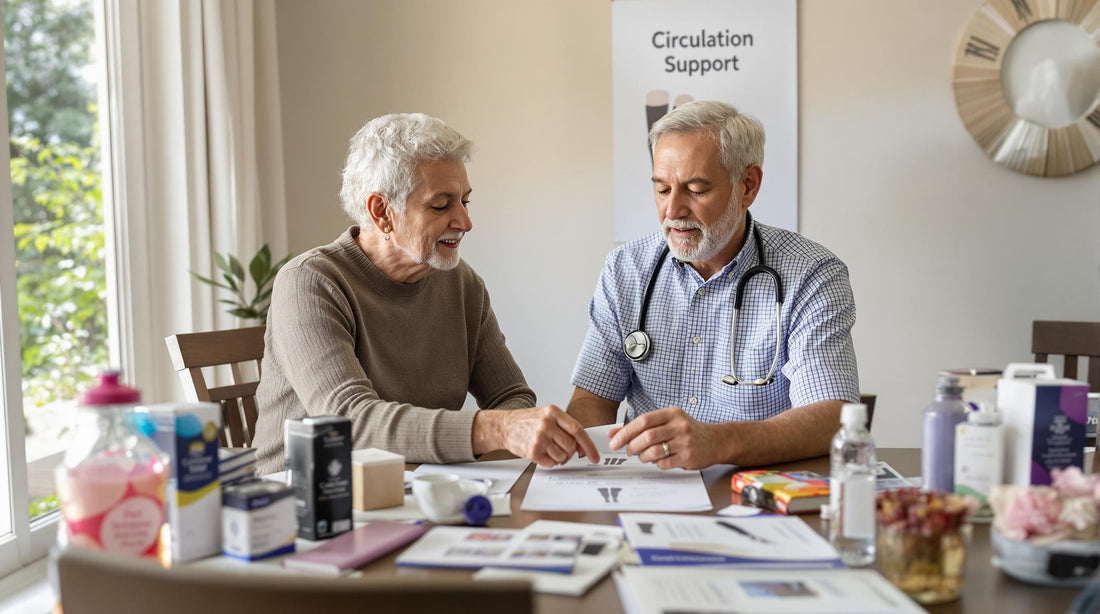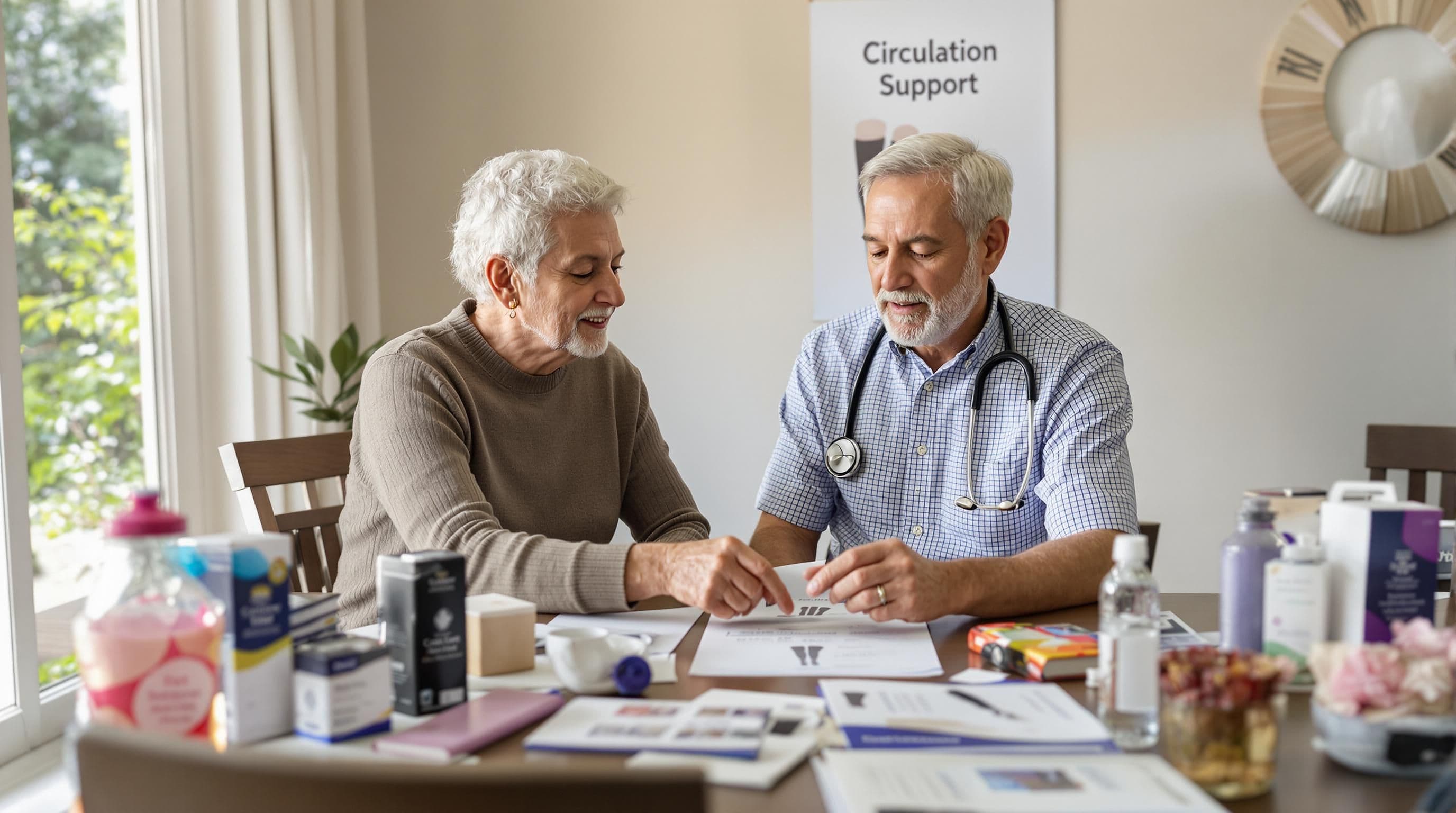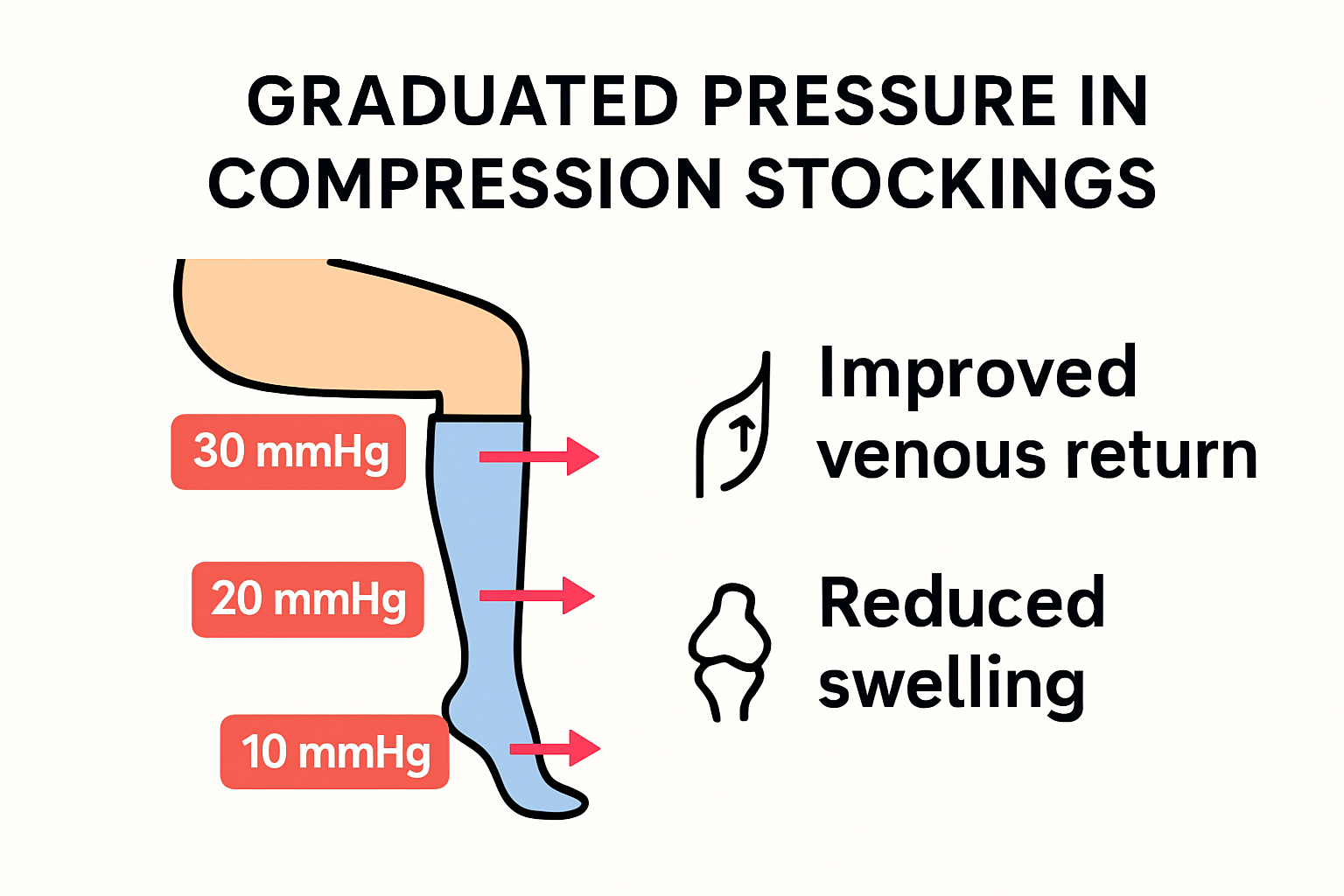
Compression Stockings Fitting Guide 2025: Find the Perfect Fit
Share

Compression stockings are popping up everywhere for people looking to improve circulation and relieve tired or swollen legs. Most folks are shocked to learn that these medical garments can actually reduce the risk of deep vein thrombosis by up to 60 percent. You might think finding the right pair is as simple as picking a size off the shelf but a single wrong measurement or compression level could make all those benefits disappear.
Table of Contents
- Understanding Compression Stockings And Their Benefits
- How To Measure For The Right Compression Stockings
- Choosing Compression Levels For Your Health Needs
- Tips For Wearing And Caring For Compression Stockings
Quick Summary
| Takeaway | Explanation |
|---|---|
| Compression stockings enhance circulation. | They apply graduated pressure to improve blood flow and reduce swelling in the legs. |
| Accurate measurement is essential for fit. | Measure your legs in the morning and follow specified techniques to ensure therapeutic effectiveness. |
| Choose compression levels based on health needs. | Different pressure levels, from low to high, address varying circulatory issues and conditions effectively. |
| Proper application maximizes effectiveness. | Use clean, dry legs and techniques that prevent bunching or folding during application for optimal support. |
| Regular maintenance prolongs stocking lifespan. | Hand wash stockings and replace every 3 to 6 months to maintain elasticity and therapeutic benefits. |
Understanding Compression Stockings and Their Benefits
Compression stockings are specialized medical garments designed to provide targeted pressure support to your legs and improve circulatory health. Harvard Health explains that these therapeutic garments work by gently squeezing leg muscles and blood vessels to enhance blood flow and reduce potential health complications.
How Compression Stockings Support Circulatory Health
The primary function of compression stockings is to apply graduated pressure that promotes healthy blood circulation. Cleveland Clinic highlights that this strategic compression helps prevent blood from pooling in lower extremities, which can lead to serious medical conditions. By creating consistent pressure from the ankle upward, these stockings assist the body’s natural blood flow mechanisms.
Specifically, compression stockings support circulatory health through several key mechanisms:
- Improved Venous Return: Compression helps push blood back toward the heart more efficiently
- Reduced Swelling: Minimizes fluid accumulation in legs and ankles
- Enhanced Muscle Support: Provides additional structural support to leg muscles during movement

Medical Conditions Benefiting from Compression Therapy
Compression stockings offer therapeutic benefits for individuals managing various health conditions. Patients experiencing chronic venous insufficiency, varicose veins, lymphedema, and those at risk of deep vein thrombosis can significantly improve their quality of life through consistent compression therapy. Athletes and professionals who spend extended periods standing or sitting also find substantial relief using these specialized garments.
The graduated pressure design ensures that compression is most intense at the ankle and gradually decreases toward the thigh. This unique engineering helps counteract gravity’s effect on blood circulation, preventing potential complications like blood clots and reducing overall leg fatigue. Whether you’re recovering from surgery, managing a chronic condition, or seeking preventative health support, compression stockings provide a non-invasive solution to support your circulatory wellness.
Choosing the right compression stocking involves understanding your specific health needs, lifestyle requirements, and consulting with healthcare professionals who can recommend the most appropriate pressure gradient and style for your individual situation.
How to Measure for the Right Compression Stockings
Accurate measurements are crucial for obtaining compression stockings that provide effective therapeutic support. Mayo Clinic recommends taking measurements at the right time and with precise techniques to ensure optimal fit and performance.
Essential Measurement Techniques
National Institutes of Health guidelines emphasize the importance of systematic measurement processes. Measurements should be taken in the morning when leg swelling is minimal, using a flexible measuring tape and standing in a neutral position. Key measurement points include:
- Ankle Circumference: Measure around the narrowest part of the ankle
- Calf Circumference: Record measurement at the widest part of the calf
- Thigh Measurement: For thigh-high stockings, measure the circumference at the widest point
Step-by-Step Measurement Process
Precision is critical when measuring for compression stockings. Begin by gathering the necessary tools: a flexible measuring tape, a mirror, and comfortable clothing that allows easy access to your legs. Stand barefoot on a hard, flat surface with your weight evenly distributed. Keep your legs relaxed and avoid pulling the measuring tape too tight or too loose.
For ankle measurements, wrap the tape around the narrowest part of your ankle, typically just above the ankle bone. Ensure the tape is level and not twisted. For calf measurements, locate the widest part of your calf and measure around its circumference. When measuring thigh circumference, stand with feet slightly apart and measure at the fullest part of the thigh.
If possible, have someone assist you to ensure accuracy. Take multiple measurements to confirm consistency. Remember that slight variations can occur, so it’s recommended to measure both legs and use the larger measurement to guarantee proper compression and comfort.
Consult with a healthcare professional if you have specific medical conditions or are unsure about your measurements. Some individuals may require custom sizing or have unique considerations that impact the fitting process. Proper measurement is not just about comfort but also about ensuring the therapeutic effectiveness of compression stockings in supporting your circulatory health.
Below is a table summarizing the key measurement points and their purposes to help ensure a proper fit for your compression stockings.
| Measurement Point | Location Description | Purpose |
|---|---|---|
| Ankle Circumference | Narrowest part above the ankle bone | Determines base sizing for graduated compression |
| Calf Circumference | Widest part of the calf | Ensures proper fit through the leg’s widest area |
| Thigh Circumference | Widest part of the thigh (for thigh-high stockings) | Adjusts fit for extended hosiery styles |
Choosing Compression Levels for Your Health Needs
Selecting the appropriate compression level is crucial for achieving optimal therapeutic benefits. Cleveland Clinic explains that compression stockings are categorized by pressure measurements in millimeters of mercury (mmHg), with each level designed to address specific health conditions and symptoms.
Understanding Compression Pressure Ranges
Yale Medicine identifies three primary compression level categories that help individuals choose the most appropriate support:
- Low Pressure (Under 20 mmHg): Ideal for mild leg fatigue, light swelling, and preventative use
- Medium Pressure (20 29 mmHg): Recommended for moderate varicose veins, mild edema, and post surgical recovery
- High Pressure (30 40 mmHg): Prescribed for significant circulatory issues, severe varicose veins, and lymphedema
Below is a comparison table outlining the different compression pressure levels, their typical uses, and examples of conditions or situations each addresses.
| Compression Level | Pressure (mmHg) | Typical Uses | Example Conditions |
|---|---|---|---|
| Low Pressure | Under 20 | Mild fatigue, light swelling, prevention | Tired legs, pregnancy, long travel |
| Medium Pressure | 20–29 | Moderate varicose veins, mild edema, recovery | Varicose veins, post-surgical swelling |
| High Pressure | 30–40 | Severe issues, medical conditions | Lymphedema, chronic venous insufficiency, DVT risk |
Matching Compression Levels to Medical Conditions
The selection of compression stockings requires careful consideration of individual health needs. National Institutes of Health research indicates that different medical conditions require specific pressure ranges to provide effective treatment.
For individuals with mild circulatory concerns or those who spend extended periods sitting or standing, low pressure compression stockings can provide relief and support. Professionals experiencing leg fatigue or pregnant women often benefit from these lower pressure garments.
Medium pressure compression stockings become essential for patients managing more pronounced circulatory challenges. Individuals with varicose veins, moderate leg swelling, or those recovering from minor surgical procedures typically require this level of compression. These stockings help improve blood flow, reduce swelling, and provide significant muscle support.
High pressure compression stockings are reserved for more serious medical conditions. Patients with chronic venous insufficiency, severe lymphedema, or significant circulatory disorders may need compression levels between 30 and 40 mmHg. These medical grade stockings provide intense pressure to counteract advanced circulatory complications.
It is critical to consult with a healthcare professional before selecting a compression level. Factors such as underlying health conditions, medication, recent surgeries, and individual physical characteristics can influence the most appropriate compression stocking. A medical expert can perform a comprehensive assessment and recommend the precise pressure gradient that will provide maximum therapeutic benefit while ensuring patient comfort and safety.
Tips for Wearing and Caring for Compression Stockings
Mount Sinai provides comprehensive guidance on the proper use and maintenance of compression stockings, emphasizing that correct application and care are crucial for maximizing their therapeutic benefits and extending their lifespan.
Proper Application Techniques
Mayo Clinic recommends specific techniques for putting on compression stockings to ensure optimal comfort and effectiveness. Begin by preparing your skin. Ensure your legs are clean and completely dry before application. If your skin is slightly damp, use a talcum powder to reduce friction and make sliding on the stockings easier.
When putting on compression stockings, turn the stocking inside out down to the heel. Gather the fabric carefully, creating a smooth tube. Slide your foot into the stocking, positioning your heel correctly. Gradually pull the stocking up, smoothing out any wrinkles as you go. Avoid bunching or folding the fabric, as this can create uneven pressure points that may cause discomfort or reduce therapeutic effectiveness.
Daily Wear and Maintenance Guidelines
Kaiser Permanente offers critical insights into daily wear and maintenance of compression stockings. Put on your stockings first thing in the morning when leg swelling is minimal. This ensures the most comfortable fit and maximum therapeutic benefit. If you have difficulty putting them on, consider using donning gloves or a special application tool designed to assist with compression garment wear.
Wash your compression stockings regularly to maintain their elasticity and hygiene. Hand wash them in lukewarm water with a mild detergent specifically designed for delicate fabrics. Avoid using harsh chemicals, bleach, or fabric softeners that can break down the elastic fibers. After washing, gently squeeze out excess water without wringing or twisting the fabric. Air dry the stockings flat, away from direct heat or sunlight.
Replace your compression stockings every 3 to 6 months, or as recommended by your healthcare provider. Over time, the elastic properties degrade, reducing the stocking’s ability to provide consistent pressure. Signs that it is time to replace your stockings include visible wear, loss of elasticity, or changes in the fabric’s texture.
Pay attention to your skin condition while wearing compression stockings. Check your legs daily for any signs of skin irritation, pressure marks, or changes in circulation. If you experience persistent discomfort, redness, or skin breakdown, consult your healthcare professional immediately. Some individuals may need to gradually increase wearing time or use additional skin protection methods.
Remember that compression stockings are a medical tool designed to support your circulatory health. Proper application, consistent care, and regular replacement are key to ensuring you receive the maximum therapeutic benefits from these specialized garments.
Frequently Asked Questions
What are compression stockings?
Compression stockings are specialized garments designed to provide graduated pressure to the legs, promoting better blood circulation and reducing symptoms like swelling and leg fatigue.
How do I measure for the right size compression stockings?
To measure for compression stockings, take measurements of your ankle, calf, and thigh in the morning when swelling is minimal. Use a flexible measuring tape and ensure you’re standing straight to get accurate results.
What compression level should I choose?
Compression levels are categorized as low (under 20 mmHg), medium (20-29 mmHg), and high (30-40 mmHg). Choose based on your specific health needs, with lower pressures for mild issues and higher pressures for severe circulatory conditions. Always consult a healthcare professional for advice.
How should I care for my compression stockings?
Wash your compression stockings regularly in lukewarm water with mild detergent, and air dry them flat away from direct heat. Replace them every 3 to 6 months or as recommended to maintain their effectiveness.
Ready to Find Your Perfect Compression Stockings Fit?
Struggling with the challenge of measuring and selecting the right compression stockings can feel overwhelming. As highlighted in our guide, an incorrect fit or pressure level not only limits the benefits but can even cause discomfort and frustration—especially if you are dealing with conditions like varicose veins, lymphedema, or pregnancy-related swelling. Getting those ankle, calf, and thigh measurements just right is critical for real improvement and daily comfort.
Discover how easy it is to apply what you have learned in this article by shopping with confidence at Fit Stockings. Our curated selection of medical-grade stockings addresses all the pain points discussed here. You will find trusted brands, detailed product info, and expert guidance on sizing tailored to your needs. Why wait and risk missing out on better circulation and more energy throughout your day? Visit Fit Stockings now to get started on your path to healthier legs and lasting relief.

